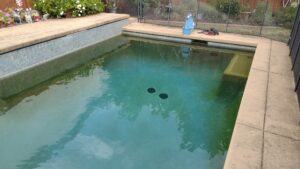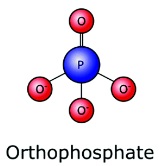Phosphates are food for algae and other micro organisms. When they get into your swimming pool water, even in trace amounts, they can wreak havoc on the quality of your pool water and water chemistry. The more phosphates that are in your pool water, the more chlorine is needed to keep the water clear and sanitized.
How do they get into your pool?
Before orthophosphates were added to our Folsom drinking water, phosphates in pool water were the byproducts of things like soaps, shampoo’s, and fertilizers. We (swimming pool service companies) treated them as they occasionally materialized. With the introduction of orthophosphate to our drinking water, treating phosphates in pools has become a monthly and even weekly occurrence. When I tested my drinking water the phosphate level was 600 parts per billion.
What are some issues you’ll see?
If you are struggling to maintain clear water in Folsom and /or keep a chlorine residual in your pool you likely have phosphates.  Phosphates are algae food. The more phosphates in the pool, the more algae grows. The more that algae grows, the more chlorine needed to kill the algae and sanitize your swimming pool water. A low phosphate level typically equals less chlorine needed to treat the pool. So, keeping phosphates out of the pool will save you money in chlorine!
Phosphates are algae food. The more phosphates in the pool, the more algae grows. The more that algae grows, the more chlorine needed to kill the algae and sanitize your swimming pool water. A low phosphate level typically equals less chlorine needed to treat the pool. So, keeping phosphates out of the pool will save you money in chlorine!
What is the recommended range?
Is there an allowable amount of phosphates in your pool water? Yes, and it’s 100ppb. Notice the “b” there. That means “parts per billion.” That’s a tiny amount. Think about it! That’s 1 drop of phosphates in 1 billion drops of water. In my experience, phosphates are manageable up to 500ppb. When the level is above 500ppb you have two options:
- Add a special chemical that removes phosphates (until you add more water, then you just reintroduced phosphates back into your pool…)
- Add excessive chlorine to keep the water clear and algae-free.
How do you treat them?
Fortunately, there are effective (albeit expensive) chemicals available to remove phosphates from your pool water. If you live in Folsom though, the next time you have add water to your pool due to evaporation, bather splash out, etc., you’re just adding phosphates back into the pool☹️.
The Solution
As things stand, if you live in Folsom, I don’t foresee a solution.
I’ve spoken to a Folsom city council member who said the City has no plans to discontinue the application of orthophosphate in our drinking water ☹️.
By the way, we tested three homes for phosphates in El Dorado Hills (which gets its water from the El Dorado Irrigation District). Two of the three had zero phosphates in their drinking water and one home tested at 100ppb. Where does the El Dorado Irrigation District get its water for EDH residents? Folsom Lake. So, why is it that the City of Folsom gets its water from Folsom Lake and needs to treat its water with orthophosphate and the El Dorado Irrigation District doesn’t?? Something doesn’t add up…
In the meantime, if you have a swimming pool in Folsom you’ll need to continue buying phosphate removers and cleaning your swimming pool filters to keep the phosphates low and in turn decrease your chlorine demand and overall swimming pool expenses.
 Why are there phosphates in Folsom water?
Why are there phosphates in Folsom water?
 Phosphates are algae food. The more phosphates in the pool, the more algae grows. The more that algae grows, the more chlorine needed to kill the algae and sanitize your swimming pool water. A low phosphate level typically equals less chlorine needed to treat the pool. So, keeping phosphates out of the pool will save you money in chlorine!
Phosphates are algae food. The more phosphates in the pool, the more algae grows. The more that algae grows, the more chlorine needed to kill the algae and sanitize your swimming pool water. A low phosphate level typically equals less chlorine needed to treat the pool. So, keeping phosphates out of the pool will save you money in chlorine!